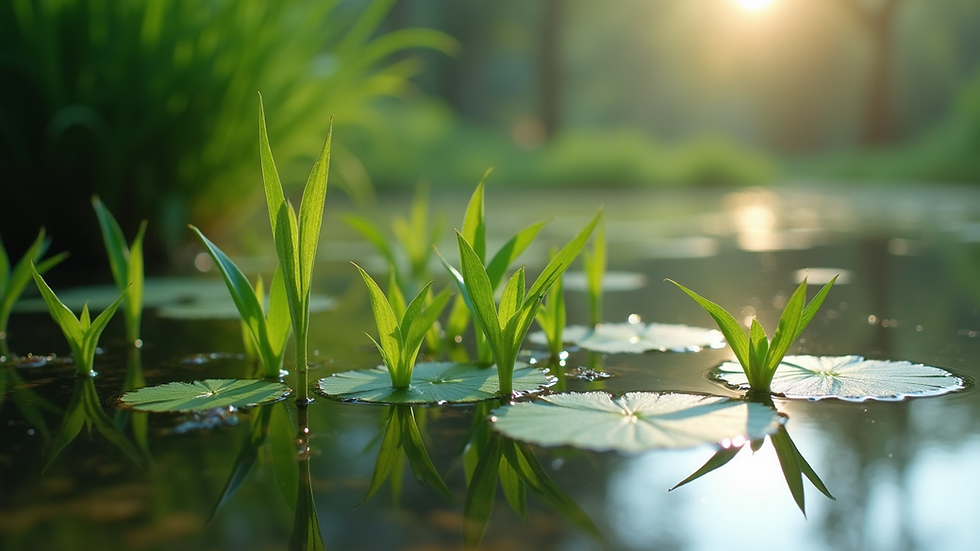Effective Strategies for Aquatic Plant Management
- Jack Wooller
- 3 minutes ago
- 4 min read
Creating and maintaining a beautiful pond is a rewarding experience. But to keep your water feature looking its best, you need to focus on healthy pond vegetation. Proper care of aquatic plants not only enhances the beauty of your pond but also supports a balanced ecosystem. In this post, I’ll share practical strategies to help you manage your pond plants effectively, ensuring your water garden thrives throughout the year.
Understanding Healthy Pond Vegetation
Healthy pond vegetation is the foundation of a vibrant aquatic environment. Plants provide oxygen, shelter for wildlife, and help control algae growth. When your pond plants are thriving, the entire ecosystem benefits.
To encourage healthy pond vegetation, start by selecting the right plants for your pond’s size, depth, and sunlight exposure. For example, water lilies flourish in sunny spots with at least 4-6 hours of direct sunlight, while submerged plants like hornwort prefer cooler, shaded areas.
Regularly check your plants for signs of stress such as yellowing leaves or stunted growth. These symptoms often indicate nutrient imbalances or poor water quality. Maintaining a balance of floating, submerged, and marginal plants will help keep your pond healthy and visually appealing.

Practical Tips for Maintaining Healthy Pond Vegetation
Maintaining healthy pond vegetation requires consistent care and attention. Here are some straightforward tips to keep your plants in top shape:
Regular Pruning: Trim dead or overgrown leaves to prevent decay and maintain plant health. This also helps control the spread of aggressive species.
Nutrient Management: Use aquatic plant fertilizers sparingly. Excess nutrients can lead to algae blooms, which compete with plants for resources.
Water Quality Checks: Test your pond water regularly for pH, ammonia, and nitrate levels. Healthy plants thrive in balanced water conditions.
Control Algae: Introduce natural algae eaters like snails or certain fish species. Avoid chemical treatments that can harm plants and wildlife.
Seasonal Care: In colder months, protect sensitive plants by moving them to deeper water or indoors if possible.
By following these steps, you’ll create an environment where your pond plants can flourish and support a diverse aquatic ecosystem.
Choosing the Right Plants for Your Pond
Selecting the right plants is crucial for a thriving pond. Consider the following categories and examples:
Submerged Plants: These grow entirely underwater and oxygenate the pond. Examples include Hornwort & Anacharis.
Floating Plants: These float on the surface and provide shade, reducing algae growth. Examples include Water lettuce & Duckweed.
Marginal Plants: These grow at the pond’s edge, helping to stabilize banks and filter runoff. Examples include Cattails & Iris.
When choosing plants, think about their growth habits and how they will interact. Avoid invasive species that can quickly take over your pond. Instead, opt for native or well-behaved plants suited to Southern England’s climate.

How to Control Overgrowth and Invasive Species
Overgrowth and invasive plants can quickly disrupt your pond’s balance. Here’s how to manage them effectively:
Manual Removal: Regularly remove excess plants by hand or with tools. This is especially important for invasive species like Canadian pondweed.
Barriers: Use pond liners or physical barriers to prevent invasive roots from spreading.
Biological Control: Introduce species that feed on invasive plants, but research carefully to avoid introducing new problems.
Professional Help: Sometimes, expert advice or services are needed to tackle severe infestations safely and effectively.
Remember, early intervention is key. The sooner you address overgrowth, the easier it is to maintain a healthy pond.
Creating a Balanced Ecosystem with Aquatic Plant Management
A balanced pond ecosystem depends on more than just plants. Fish, insects, and microorganisms all play a role. Effective aquatic plant management means understanding how plants fit into this system.
For example, plants provide shelter and breeding grounds for fish and amphibians. In return, fish help control algae and insect populations. By maintaining a variety of plant types and keeping their growth in check, you support a self-sustaining environment.
Regular monitoring and adjustments are part of this process. Keep an eye on plant health, water clarity, and wildlife activity. When you notice imbalances, take action promptly to restore harmony.
Tips for Seasonal Pond Care and Plant Maintenance
Each season brings different challenges and opportunities for pond care:
Spring: This is the best time to plant new aquatic vegetation and remove winter debris. Check for damage and prepare your pond for growth.
Summer: Monitor water levels and temperature. Prune aggressively growing plants and watch for algae blooms.
Autumn: Remove fallen leaves and dying plants to prevent decay. Consider adding pond aeration to maintain oxygen levels.
Winter: Protect sensitive plants by moving them to deeper water or indoors. Reduce feeding fish to match their slower metabolism.
By adapting your care routine to the seasons, you’ll keep your pond healthy year-round.
Encouragement for Your Pond Journey
Managing pond plants might seem challenging at first, but with patience and consistent care, it becomes a rewarding hobby. Every small step you take contributes to a thriving aquatic environment that brings peace and beauty to your property.
If you ever feel unsure, don’t hesitate to seek advice from specialists who understand the unique needs of ponds in Southern England. Remember, your pond is a living ecosystem, and your efforts help it flourish.
Enjoy the process, and watch your healthy pond vegetation grow into a stunning feature you can be proud of.
I hope these strategies inspire you to take confident steps toward managing your pond plants effectively. With the right approach, your water feature will remain a beautiful, balanced haven for years to come.




Comments